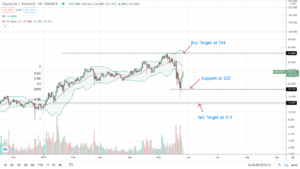
Decentralized finance (DeFi) is no longer new among the crypto community. It has been gaining notoriety in the last few years, and DeFi is now an industry on its own. When we talk about the asset classes running the DeFi space, we cannot ignore wrapped assets, which are now a critical player in exploiting the multitude of use cases and functionalities in decentralized finance. This write-up will explain wrapped cryptocurrency assets in detail to help cryptocurrency and DeFi enthusiasts understand their importance and where they fit in the larger cryptocurrency industry. What are Wrapped Cryptocurrency Assets? A wrapped asset can be simply defined as a cryptocurrency token pegged to another asset. However, this definition makes wrapped assets much similar to stablecoins. For a more elaborate representation, a wrapped is a token that represents the original coin in a foreign blockchain. It is called a wrapped asset because the original crypto coin is put in a digital vault called the wrapper that allows it to exist on a non-native blockchain. The wrapped asset holds the same value as the original cryptocurrency, and apart from being used on other blockchains, some wrapped assets are redeemable for the original coin. Essentially, wrapped assets exist in two types. However, it is widely conceded that stablecoins were the first class of wrapped assets regardless of the massive differences. The more established wrapped cryptocurrency assets include the redeemable and cash-settled wrapped assets. Cash-settled assets are not redeemable for the underlying asset, while the redeemable types are exchangeable with the underlying asset. How do Wrapped Cryptocurrency Assets Work? Wrapped assets rely on the workings of merchants and custodians, and this has been labeled among the drawbacks of these assets. Merchants help you when you want to wrap a cryptocurrency by sending your requests to custodians, who then wrap and store your deposited crypto coin. If you hold a redeemable wrapped asset and want to exchange it for the original coin, the merchant will again forward a burning request to the custodian. Wrapped Bitcoin, WBTC, is the most used and held wrapped asset. If you want to acquire WBTC, you can wrap your Bitcoin holdings by finding a merchant like Airswap, DiversiFi, Kyber, Ren, or DDEX. WBTC functions on the Ethereum blockchain and has partnered with a couple of merchants that can help send your wrapping requests to BitGo, its custodian. The merchant you choose sends your Bitcoin to the custodian who mints new WBTC and holds your deposit at a 1:1 ratio. When you decide to redeem the WBTC for BTC, the merchant will initiate a burning request, and the custodian will destroy the WBTC then return your BTC. The system always ensures that there is one Bitcoin backing for every WBTC, which makes wrapped cryptocurrency assets much similar to stablecoins. The Importance of Wrapped Cryptocurrency Assets Cryptocurrencies exist on individual blockchains. Bitcoin, for instance, exists on the Bitcoin blockchain, while Ethereum exists on the Ethereum blockchain. The protocols have fundamental differences in their algorithms and functionalities, making interacting difficult. As a result, the independent blockchains create an interoperability challenge in the crypto ecosystem, which wrapped assets attempt to solve. By minting Bitcoin into WBTC, it becomes possible to leverage the liquidity of Bitcoin on the Ethereum blockchain. WBTC can then operate as an ERC-20 standard token and be used in decentralized finance applications on the Ethereum network. The asset’s value remains the same, but users can enjoy the enormous functionalities in DeFi, including efficient, fast, and smooth movement of funds. Wrapped ether (WETH) is also a prominent wrapped cryptocurrency asset that launched before WBTC. However, unlike wrapped Bitcoin, which specifically serves to allow Bitcoin to exist on foreign blockchains, wrapped Ethereum is meant for use on the Ethereum blockchain. Ethereum is the native token of the Ethereum blockchain. It precedes the decentralized finance protocols, and it, therefore, does not conform to the ERC-20 token standards. By wrapping your ETH into WETH, you convert it into a tradable version of ETH, ERC-20, compliant with the ERC-20 standards and DeFi protocols. For one to acquire WETH, you do not need to use a merchant like with WBTC. You can trade your ETH directly to WETH via a smart contract or a digital wallet like MetaMask. The Bottom Line While the idea of wrapped cryptocurrency assets appears to relate closely with the concept of stablecoins, the two have significant differences right from their inspiration. Stablecoins came to deal with the volatile nature of cryptocurrencies by pegging them to assets that have more stability in value. On the other hand, Wrapped assets came to solve the interoperability problem between different blockchains. However, with the birth of the decentralized finance industry, wrapped assets found more use cases, and they are now more than just bridges between blockchain networks. They are now … Continued
The post Understanding the Importance of Wrapped Cryptocurrency Assets: Where Do They Fit In? appeared first on Cryptoknowmics-Crypto News and Media Platform.
- Coinsmart. Europe’s Best Bitcoin and Crypto Exchange.
- Platoblockchain. Web3 Metaverse Intelligence. Knowledge Amplified. FREE ACCESS.
- CryptoHawk. Altcoin Radar. Free Trial.
- Source: https://www.cryptoknowmics.com/news/understanding-the-importance-of-wrapped-cryptocurrency-assets-where-do-they-fit-in/
- "
- About
- acquire
- algorithms
- among
- Another
- applications
- asset
- Assets
- bbc
- being
- Bitcoin
- BitGo
- Block
- blockchain
- BTC
- cases
- challenge
- Coin
- community
- compliant
- concept
- contract
- Couple
- critical
- crypto
- Crypto ecosystem
- cryptocurrencies
- cryptocurrency
- deal
- decentralized
- Decentralized Finance
- DeFi
- destroy
- detail
- different
- digital
- digital wallet
- Display
- Diversifi
- documentary
- ecosystem
- efficient
- Elaborate
- enormous
- ERC-20
- established
- ETH
- Ether
- ethereum
- Ethereum blockchain
- ethereum network
- exchange
- FAST
- finance
- First
- fit
- Forward
- found
- funds
- help
- hold
- holds
- How
- HTTPS
- idea
- importance
- include
- Including
- individual
- industry
- Inspiration
- Interoperability
- IT
- larger
- Leverage
- Line
- Liquidity
- MAKES
- Making
- massive
- Media
- Merchant
- Merchants
- MetaMask
- more
- most
- movement
- multitude
- Nature
- network
- networks
- news
- Other
- partnered
- player
- possible
- Problem
- prominent
- protocols
- represents
- requests
- running
- significant
- similar
- smart
- smart contract
- SOLVE
- Space
- specifically
- Stability
- Stablecoins
- standards
- store
- system
- Talk
- token
- trade
- trader
- understand
- use
- users
- value
- Vault
- Wallet
- wBTC
- What
- WHO
- Work
- years












